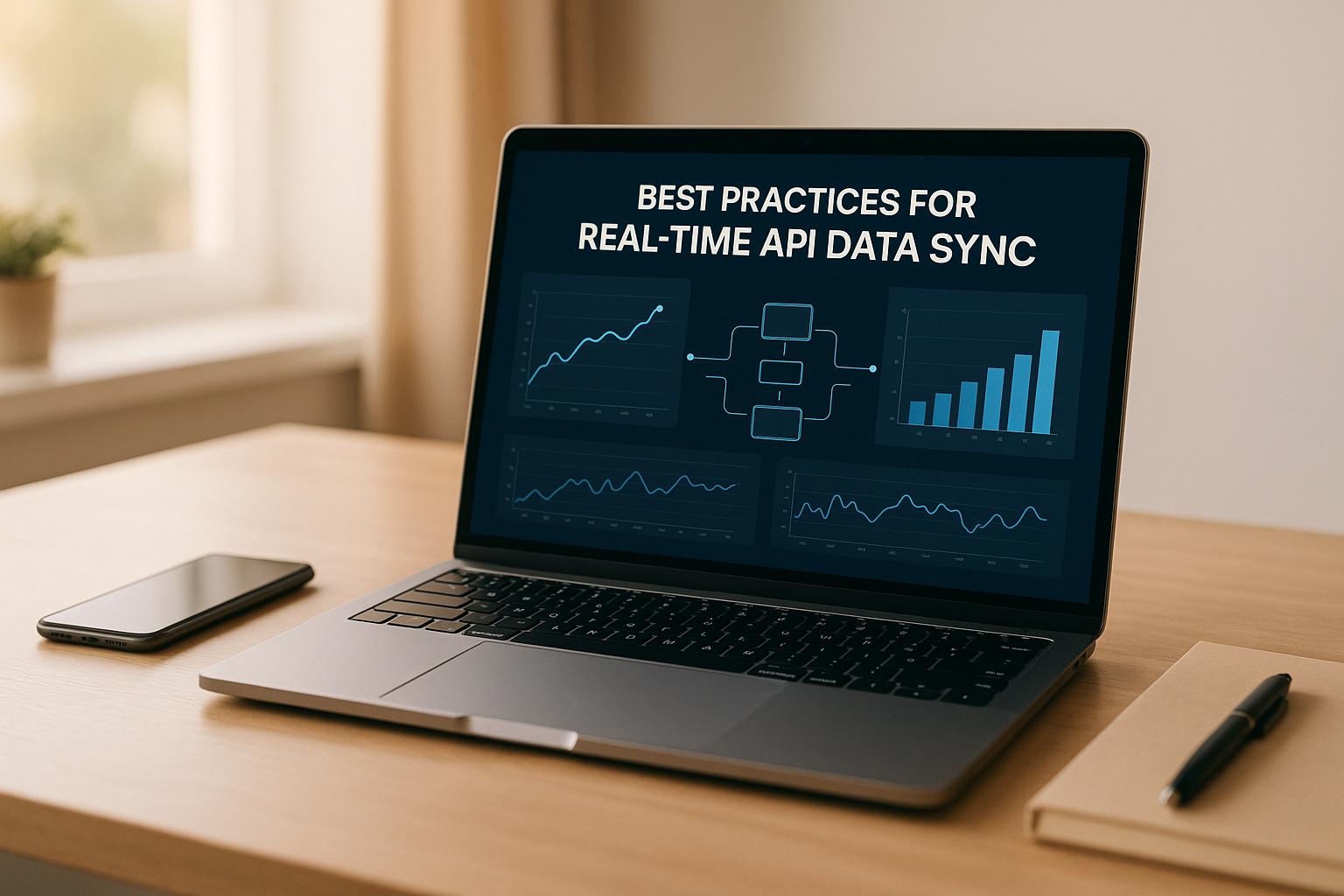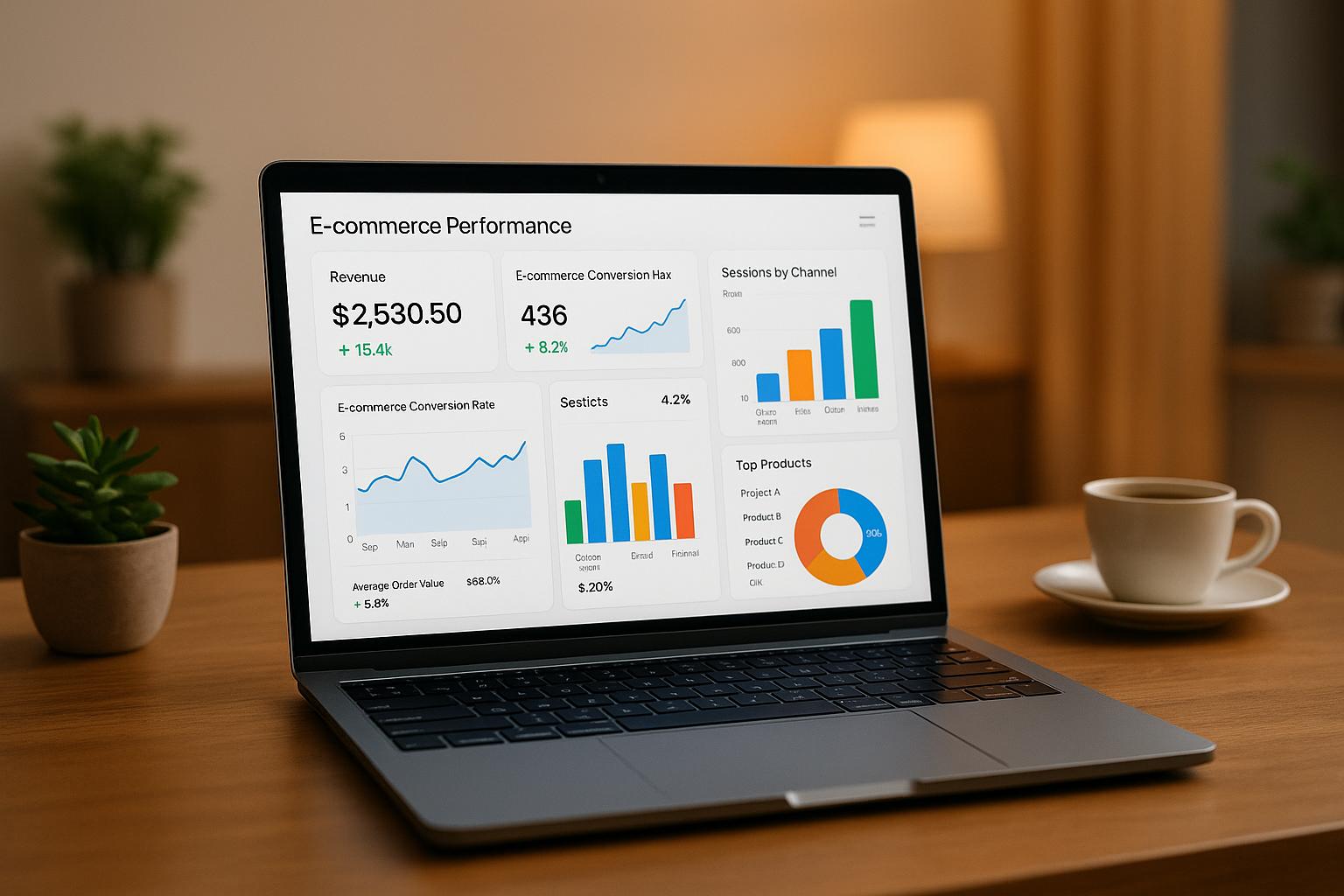Business Intelligence (BI) transforms how companies approach omnichannel marketing by turning customer data into actionable insights. Here's what you need to know:
- BI-driven marketing boosts results: A 2024 Gartner study found BI strategies increase customer retention by 23% and cross-channel sales by 15%.
- Unified customer profiles: Tools like CDPs integrate data from websites, apps, social media, and physical stores to deliver personalized experiences.
- Predictive analytics: BI tools forecast customer behavior, enabling real-time adjustments and smarter campaigns.
- Proven success stories: Starbucks, Sephora, and Best Buy have seen higher conversions and sales growth through BI.
BI is the key to creating seamless, data-driven customer journeys across channels. Ready to learn how? Let’s dive in.
Optimizing omnichannel marketing efforts with a data and ...
Omnichannel Marketing Today
Omnichannel marketing focuses on creating smooth interactions across both digital and physical touchpoints. Businesses are moving away from isolated channels and toward cohesive customer experiences. Here's a quick breakdown of how this approach compares to multichannel marketing.
Omnichannel vs. Multichannel: Key Differences
While both strategies use multiple channels, they differ in execution and results. Omnichannel marketing ensures a unified and consistent customer experience, while multichannel marketing treats each channel as a separate entity.
| Aspect | Omnichannel | Multichannel |
|---|---|---|
| Data Integration | Centralized customer data across channels | Data siloed by channel |
| Customer Experience | Smooth transitions between channels | Separate experiences per channel |
| Campaign Management | Unified messaging across platforms | Channel-specific campaigns |
| Customer Recognition | Single customer profile across touchpoints | Different profiles for each channel |
| Performance Tracking | Comprehensive journey analytics | Metrics limited to individual channels |
Omnichannel marketing also aligns with the different stages of a customer's journey, ensuring a connected experience throughout.
5 Stages of the Customer Journey
-
Acquisition
Leverage integrated data to pinpoint and attract potential customers. -
Conversion
Cross-channel tracking ensures a smooth shift from awareness to purchase. -
Growth
Tailored recommendations based on past behavior encourage repeat purchases. -
Retention
Delivering consistent experiences across channels builds long-term loyalty. -
Win-back
Use data to re-engage inactive customers and bring them back into the fold.
BI Tools in Omnichannel Marketing
BI tools turn raw data into insights that drive omnichannel marketing strategies. These insights align perfectly with the unified customer experience discussed earlier.
Combining Data for Customer Profiles
Modern BI systems bring together data from various channels to create detailed customer profiles. Customer Data Platforms (CDPs) are essential here, as they:
- Combine customer interactions from multiple channels
- Build dynamic audience segments
- Enable precise, targeted messaging
- Track and map customer journey stages
| Data Type | Source | Marketing Application |
|---|---|---|
| Behavioral | Website analytics, app usage | Personalized content delivery |
| Transactional | POS systems, e-commerce | Analyzing purchase patterns |
| Demographic | CRM, surveys | Fine-tuning audience segmentation |
| Engagement | Email, social media | Understanding channel preferences |
Armed with these profiles, BI tools can predict customer behavior with greater accuracy.
Using Data to Predict Customer Behavior
AI-driven BI tools sift through past data to predict customer behavior and improve engagement strategies. These tools can help marketers:
- Spot potential buyers
- Identify customers at risk of leaving
- Suggest the next best actions to take
For instance, by analyzing website usage patterns, AI can provide recommendations to improve conversion rates. This allows marketers to tweak their strategies on the fly.
These predictive insights pave the way for immediate, real-time actions.
Live Campaign Tracking
BI dashboards provide real-time updates on campaign performance. With this data, marketers can:
- Track essential campaign metrics
- Adjust messaging instantly
- Make smarter budget decisions
Many modern BI platforms connect seamlessly with marketing analytics tools, consolidating performance data from multiple channels into one dashboard. This integration helps marketers make informed decisions quickly and efficiently.
For those looking to enhance their omnichannel marketing efforts, the Marketing Analytics Tools Directory offers a range of BI tools designed to simplify campaign tracking and boost performance.
sbb-itb-5174ba0
3 Steps to Add BI to Marketing
To make the most of Business Intelligence (BI) in your marketing efforts, follow these three practical steps to integrate it seamlessly into your operations.
1. Set Clear Marketing Goals
Start by defining specific, measurable KPIs that align with your overall business strategy. For example:
- Increase customer retention rate by 25% within six months.
- Lower customer acquisition costs (CAC) from $150 to $100 by Q4 2025.
- Improve cross-channel conversion rates by 15% in the next quarter.
Having well-defined goals ensures your BI efforts stay focused and results-driven.
2. Evaluate Your Current Tools
Take a close look at your marketing technology stack to ensure everything integrates smoothly and avoids creating data silos. Use this checklist to guide your evaluation:
| Tool Type | Integration Checklist |
|---|---|
| CRM Systems | API compatibility, data export options |
| Analytics Platforms | Real-time sync capabilities |
| Marketing Automation | Webhook support, custom integrations |
| E-commerce Platforms | Data format compatibility |
Once you've assessed your tools, confirm that your data collection methods can work with a centralized BI system. This will help you identify any gaps before selecting the right BI software.
3. Choose the Right BI Software
When selecting BI software, focus on these key factors to ensure it meets your marketing team's needs:
- Data Integration and Analytics: Look for software that integrates with your existing tools, creates detailed customer profiles, predicts behaviors, and enables real-time campaign tracking.
- Ease of Use: The platform should have an intuitive interface that your team can use without requiring extensive training.
- Scalability: Choose a solution that can grow with your business, handling increased data volumes, users, and advanced features.
For help finding the best BI tools for marketing, check out the Marketing Analytics Tools Directory. It’s a great resource for comparing options tailored to your technical and operational needs.
Measuring BI Marketing Results
Setting Up Performance Metrics
To measure how Business Intelligence (BI) impacts omnichannel marketing, it's crucial to track both individual channel metrics and overall cross-channel performance. The table below outlines key performance metrics to monitor:
| Metric Type | Key Indicators | Measurement Frequency |
|---|---|---|
| Channel Performance | Conversion rates, engagement time, bounce rates | Daily/Weekly |
| Cross-Channel Impact | Attribution modeling, customer journey completion | Weekly/Monthly |
| Customer Behavior | Path to purchase, channel preferences, response rates | Real-time/Daily |
| ROI Metrics | CAC by channel, ROAS, customer lifetime value | Monthly/Quarterly |
Start by establishing baseline metrics before rolling out new BI-driven strategies. This provides a reference point to measure progress and highlights areas that may need adjustments. These baselines serve as a roadmap for ongoing improvements.
Key Areas to Monitor:
- Engagement levels across different touchpoints
- Accuracy of channel attribution
- Response rates to personalized campaigns
- Patterns in cross-channel conversions
- Customer acquisition costs broken down by channel
Using Data to Improve Results
Once metrics are in place, the next step is turning data insights into actionable marketing improvements. BI insights can help you fine-tune campaigns and ensure a seamless omnichannel experience.
Real-Time Optimization Techniques:
- Identify where users drop off in their journey
- Adjust campaigns based on live data trends
- Experiment with different messaging across platforms
- Use behavioral data to refine audience targeting
For tools that support real-time analytics and campaign tracking, explore the Marketing Analytics Tools Directory.
Key Factors for Success:
- Regularly check data quality
- Ensure cross-channel performance is measurable
- Set up automated alerts for any performance dips
- Continuously test and adjust strategies
- Share clear reports with stakeholders
Pairing hard numbers with qualitative feedback can help you sharpen your omnichannel marketing strategy even further.
Conclusion
Business Intelligence (BI) is reshaping omnichannel marketing strategies, driving an average 9.5% revenue increase and 7.5% cost reduction.
For example, NA-KD achieved a 72x ROI using personalized omnichannel campaigns. Similarly, Best Buy boosted email click-through rates by 22% after implementing BI-driven audience segmentation.
"BI transforms guesswork into precision - companies using cross-channel analytics see 2x faster decision-making and 50% higher customer satisfaction." - McKinsey
The future of BI in omnichannel marketing looks bright, with the market expected to grow to $36.11 billion by 2025. Advances in AI-powered analytics and real-time data processing are enabling marketers to deliver more tailored and impactful customer experiences across channels.
To successfully implement BI in omnichannel marketing, focus on these areas:
- Unified Data: Combine customer data from all touchpoints for a complete view.
- Real-Time Analytics: Use live performance data to adjust campaigns instantly.
- AI Integration: Apply predictive analytics to enhance customer engagement.
- Cross-Channel Measurement: Analyze and optimize performance across every channel.
Mobile BI is also on the rise, growing at a 15.3% CAGR through 2032. This growth allows marketers to make informed decisions on the go, ensuring seamless customer experiences no matter the platform.
FAQs
How can businesses seamlessly integrate BI tools into their marketing tech stack to improve omnichannel strategies?
Integrating business intelligence (BI) tools into your marketing technology stack can transform your omnichannel strategies by providing deeper insights and enabling data-driven decisions. To achieve this, start by ensuring your BI tools are compatible with existing platforms, such as CRM systems, email marketing software, and analytics dashboards. This allows for smooth data flow and centralized reporting.
Next, use BI tools to analyze customer behavior across channels, track campaign performance, and identify trends. These insights can help you create more personalized and consistent experiences across touchpoints. Additionally, focus on real-time analytics to quickly adapt to changing customer preferences and optimize your strategies.
By leveraging BI tools effectively, businesses can unify data from multiple sources, enhance decision-making, and deliver cohesive messaging that resonates with their audience across all channels.
How can predictive analytics boost customer engagement in omnichannel marketing?
Predictive analytics can significantly enhance customer engagement by helping businesses anticipate customer needs and preferences across all channels. By analyzing historical data, businesses can identify patterns and trends to deliver more personalized experiences, such as tailored product recommendations or targeted promotions.
For example, predictive models can forecast which customers are likely to engage with specific campaigns, enabling marketers to allocate resources more effectively. Additionally, predictive analytics can optimize timing by determining the best moments to send messages or offers, ensuring they resonate with the audience. These insights empower businesses to create seamless, data-driven omnichannel strategies that foster stronger connections with their customers.
What key metrics should businesses track to evaluate the success of BI-powered omnichannel marketing strategies?
To measure the success of business intelligence (BI) in omnichannel marketing, businesses should focus on tracking metrics that provide actionable insights into customer behavior, campaign performance, and overall ROI. Here are a few key metrics to consider:
- Customer Lifetime Value (CLV): Understand the long-term value each customer brings across all channels.
- Conversion Rates: Track how effectively campaigns are turning leads into customers.
- Channel Performance: Evaluate how individual channels (email, social media, in-store, etc.) contribute to overall marketing success.
- Customer Retention Rate: Measure how well your business retains customers over time.
By analyzing these metrics, businesses can optimize their omnichannel strategies to deliver a seamless and data-driven customer experience.


